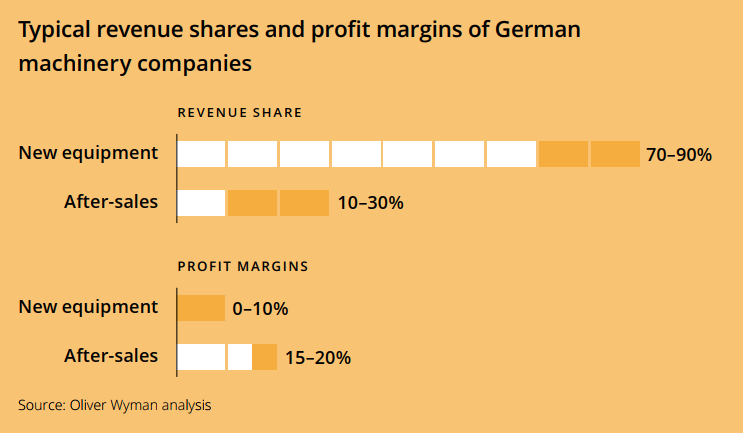Do you want to make your after-sales more efficient?
Maybe roll out new business models, all while increasing customer loyalty? Digital after-sales is the solution. Read how manufacturers can get started easily and grow as they go.
Digital after-sales for manufacturers
After-sales has always been a major business driver in manufacturing. Spare parts, consumables, services - the possibilities are endless. With digitalization, the aspect of personalization opens up new dimensions of growth, making digital after-sales essential for manufacturers. The sooner executives recognize the challenges and increasing opportunities of digital after-sales, they will place more emphasis on the sales of spare parts and services.

OEMs can position themselves as a one-stop store for products and equipment by having their own after-sales business and thus support their customers even after the product or machine has been purchased. In an online customer portal, manufacturers can respond to the needs of different user groups individually, leverage new sales potential and offer innovative business models.
3 benefits of digital after-sales
According to our customers, such as SPINNER, these are the 3 most impactful benefits of having a long-lasting after-sales phase:
- More profit for manufacturers, as additional products and services are offered
- More customer loyalty, as the competitive pressure is reduced by optimized products, even based on their installed base
- More efficiency for B2B buyers, since a digital customer portal can be adapted to customers' processes
Do you want to benchmark yourself against your competitors? Here's our latest industry report:
Digital after-sales: Start small, then grow as you go
At Intershop, more than 300 customer projects have given us insights in how to make a project of digitizing manufacturing a long-term success. Learn how to start and grow your strategy today with after-sales!
👉Here are the 5 steps that lead to more customer loyalty, higher margins and scaling sales:
1. Set up a basic website with relevant information
Start by setting up an educational website without commerce functionality. It could offer product lists and machine descriptions as pdf downloads. Prices and sales information don't need to be provided yet, but be sure to present your network of distribution partners to make sure your (future) customers will be able to make the next step.
2. Streamline data and implement buying functionality
Set up a project to introduce buying functionality for consumables and spare parts integrated in your website. Tear down data silos! Digitize and streamline all the (dispersed) product information into one single source of truth to make sure your customers order the right products. This will lead to a unified experience on every touchpoint and improve your churn rate.
3. Personalize EVERYTHING for exceptional user experience
Extend the functionality of your customer portal by enabling your customers to register their machines online. Personalize the range of spare parts and consumables based on those registered machines ("installed base"). Make sure that your sales team is aware of the advantages of this digitization and supports your customers in the first self-services (for example, master data maintenance or invoice overviews).
In this phase, recurring orders are already detached from personal consultation with sales reps. On-site appointments should focus on supporting customers in the use of their machines, identifying new trends and picking up the requirements that will ultimately play a part in the development of new machines.
4. More data! Connectivity is king.
Extend the portal via API gateways to include data collected via e-commerce, CRM systems, the (Industrial) Internet of things, and analysis tools. They are a good basis for increasing personalization or adding best-of-breed applications to make your customer portal stand out from your competitors. The aftermarket and the challenges of digital after-sales play a major role in this phase.
For example, it is very crucial for OEMs to distribute relevant and up-to-date data of machines, equipment and spare parts along the distribution network during the entire lifetime of the product.
5. Artificial intelligence for new business models
Add even more data from sources such as sensors on your machines and expand your digital portal with innovative technologies for the development of new business models such as predictive maintenance. This is where machine learning, AI and Cloud infrastructures come into play. Provide your customers with real-time information about their installed base! It’s the dawn of a new era in digital after-sales. Look forward to more customer satisfaction and loyalty!
How can the aftermarket be digitalized?
When purchasing a spare part for service or repair, customers need to be provided with accurate aftermarket information. We have a whitepaper that discusses the importance of a tight integration of an aftermarket PIM and a digital customer portal with personalization strategies. Download now! 






